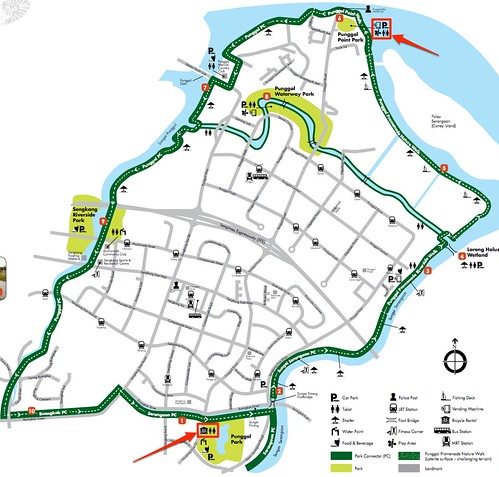The North-Eastern Riverine Loop was just opened and features views of the Punggol and Serangoon Reservoirs, linking Hougang, Punggol and Sengkang towns and the following sites:
- Punggol Point Park (road end)
- Punggol Promenade
- Punggol Beach
- Punggol Waterway Park
- Sengkang Riverside Park
- Punggol Park (off Hougang Ave 10)
- Lor Halus Wetland
Six existing park connectors are linked:
- Punggol Park Connector,
- Punggol Promenade,
- Serangoon Park Connector,
- Sungei Serangoon Park Connector,
- Buangkok Park Connector and
- Punggol Waterway.
Download the e-guide from NParks here.
The best way to enjoy the 26km trail is in the evening when the sun is setting over the west. And the good news - you can rent a bicycle if you do not have one either at
- Punggol Point Park in the north - map link; bus no 84).
- Punggol Park in the south - map link; bus nos. 62, 74, 113, 119, 147, 74E; 80, 82, 87, 88, 89, 119, 89E, NR6)
The map below (click to enlarge) shows you the locations of these bicycle rental kiosks, thanks to Trina Chua from NParks for the information.
Both bicycle rental kiosks are open; timings:
- Tue to Fri from 2pm to 8pm and
- Sat and Sun from 9am to 8pm.
Note that you have to return the bicycles from the kiosk you borrowed it from, i.e. they are independent of each other. A leisurely 26km ride with stops might take 3-hours (there is a 15 km/h speed limit), so do plan your ride well - come by the park and rent your bicycle by 5pm if you intend to take in the sights and grab some photos.
Now, get on that bike and ride!
Links
- Photos from NERL - Alvin WOn, 22 Jul 2012
- "Biking to Punggol Promenade on 26 October 2011," by Ng Cher Choon. Biking Experiences, 14 Nov 2011 - link.
- Walter Lim blogs about the launch of NERL with lots of photos at Coolest Insights.
- NParks press release, 25 Feb 2011 - link.
- NParks e-guide link









